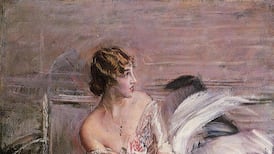Wandering amid the beaux arts beauty of the Musée d’Orsay in Paris recently, with its feast of impressionist masterpieces by Monet, Renoir and Degas, I was startled to be confronted by a giant picture of cattle in a field.
Not placidly grazing cattle either. Ploughing in the Nivernais depicts a dozen Charolais bullocks, straining every muscle and drooling from the effort as they pull two wooden ploughs through a field in France in the mid-19th century.
The picture is said to have been inspired by a scene from a George Sand novel but its realism and clarity is such as to put you in the field with the ploughmen, dwarfed behind their beasts of burden. The effect was too much for some early viewers. A young Paul Cezanne found it "horribly like the real thing".
Even so, the painting was a sensation at the 1849 Paris Salon, winning a medal and launching the career of its 27-year-old creator, Rosa Bonheur.
Born 200 years ago, on March 16th, Bonheur would grow up to turn several artistic and social conventions on their head. For one thing, reversing the usual story, she was hugely successful in her lifetime. It was only in later years, and since, that she sank into neglect
Rich and famous by 40 in a world dominated by men, she worked in a doubly-male milieu, choosing animals as her speciality and researching them meticulously in fairgrounds, abattoirs and other places normally off-limits to women.
Although herself diminutive, she liked her art big. Even Ploughing in the Nivernais is dwarfed by a later work, The Horse Fair (1855) which is almost 2.5m high and 5m wide and has been called "the world's greatest animal painting". American millionaire Cornelius Vanderbilt paid a staggering $53,000 for that in 1887, before donating it to New York's Metropolitan Museum of Modern Art. But by then the artist had already earned enough from its first sale, and multiple reproductions, to buy a 17th-century chateau.
Bonheur is generally presumed to have been a lesbian, although the question was not raised explicitly. She lived with another woman, Nathalie Micas, for over 40 years. She was also noted as a heavy smoker, unthinkable behaviour for most women of the era. Above all, she was famous for wearing men's clothes: something for which women needed a legal permit.
Given the nature of her work, there were practical considerations involved. Here for example is a fashion writer for The Irish Times, from 1893, explaining why an increasing number of high-profile women, including Bonheur, were flouting sartorial norms:
“When she visits the fairs where she makes sketches...her dress consists of a labourer’s blue smock coat and cap. This not only enables her to get the necessary studies, but it also protects her from the rough countrymen with whom she comes into contact.”
Since the French Revolution, a law had forbidden women from wearing men’s clothes unless they had a “permission de travestissement” from the police. Bonheur duly applied, complete with doctor’s cert, and wore her trousers legally.
Man’s world or not, she succeeded where her father – also an artist – had failed. He had moved his family from Bordeaux to Paris when Rosa was seven, then abandoned them for a time to take up with a utopian Christian-socialist sect, the Saint-Simonians.
After a few years of supporting the family with sewing and piano lessons, Rosa's mother died and went to a pauper's grave. Only then did Raymond Bonheur take over the child rearing, teaching them all to paint but focussing on Rosa.
Challenging as Cezanne found them, Bonheur's canvasses of working animals were in sympathy with the revolutionary spirit of 1848 and the short-lived Second Republic that followed. She was a socialist, yet adapted seamlessly to the coup that brought Napoleon III to power in 1852. She was perfectly at ease with royalty, including Britain's Queen Victoria, who were among her biggest admirers in subsequent years.
But then as Irish art critic Brian Fallon summed up, Bonheur typified a 19th- century phenomenon: "Not the artist as visionary, or the artist as aesthete, or the artist as social revolutionary, but the artist as craftsman. She was utterly a pro; hard-working...disciplined, stolidly ambitious."
One measure of her fame is that, for an 1877 advertisement in this paper, Brown Thomas announced its autumn collection of costumes from Paris, “including the new Gertrude, Francien, and Rosa Bonheur”.
Habits were changing generally then. Even in France, women had stopped bothering to apply to the police for cross-dressing licences. Separately, meanwhile, Bonheur’s art had begun a long fall from fashion, out of which it is still struggling to re-emerge.











